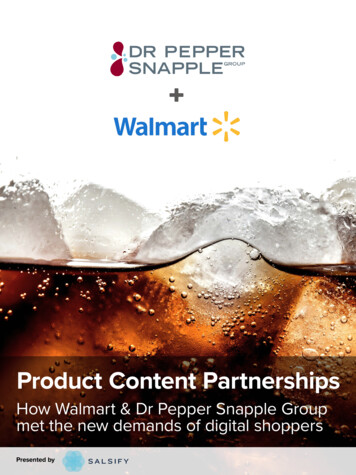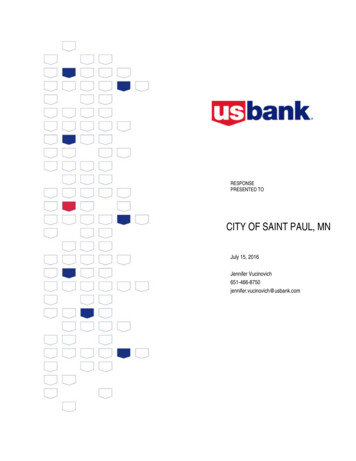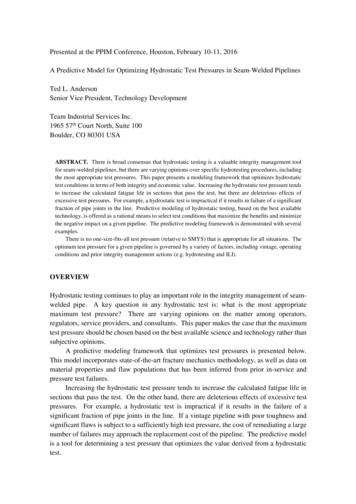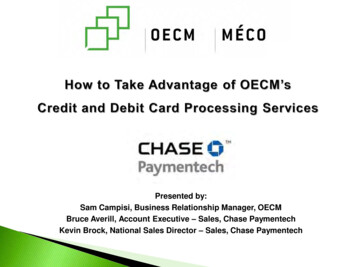
Transcription
Product Content PartnershipsHow Walmart & Dr Pepper Snapple Groupmet the new demands of digital shoppersPresented by
If you’re reading this case study, statisticssay you have a smartphone. In fact, 72% ofadults in the United States own one.1 That’sa mind-blowing rate of adoption — withless than ten years in the market, (the firstiPhone release was June 2007), almostthree-quarters of the United States adultpopulation has a computer in their pocket.This transformation — access to information whenever andwherever we happen to be — has disrupted the way manymarkets have operated — commerce being one of the top.As consumers, we want to make the best purchase decision forevery product we buy. It’s about being informed — and we seekthat information on our phones, computers, and tablets. In fact,82% of us that own a smartphone use it while we’re in-storeto help us make a purchase decision.2 This has real revenueimplications. Forrester Research expects 42% of US in-storesales to be influenced by the Internet by 2020.3“We’ve seen a wave of technology starting toinfluence buyers in new ways. We set out totackle that.”Jordan Ste. MarieSr. Manager, Ecommerce MarketingDr Pepper Snapple GroupFocusing on the new shopping experience — one where thedigitally empowered consumer is at the center — meansensuring your products can be found no matter how he orshe decides to shop. The new focus is building bonds betweenbrand and retailer. It is transforming commerce and changingthe role of product content from an operational burden to thedriver of commerce currency.As consumers “click and collect” their way across the web, anybrand or retailer that doesn’t have the relevant product contentin place is invisible to a digital shopper and risks losing a placein the purchase decision.Dr Pepper Snapple Group confronted the reality of this new ageof shopping with a hard look at their strategies. The companysaw that serving a changing consumer would require not onlynew people, processes, and technologies — but also a new levelof partnership and coordination between retailers and brands.At the center of these strategies, they had to figure out how tomanage, optimize, and syndicate product content from brand1Pew Research Center, Feb 20162Consumers in the Micro-Moment, Google/Ipsos, U.S., March 20153Forrester Research Web-Influenced Retail Sales Forecast, 2015 to 2020to retailer to the consumer in the most efficient, consistent, andmeaningful way possible.“We’ve seen a wave of technology starting to influence buyersin new ways. We set out to tackle that,” says Jordan Ste. Marie,Senior Manager of Ecommerce Marketing at Dr Pepper SnappleGroup. “Grocery is about to change as we know it, and it’s goingto become this omnichannel experience where your brands can’tafford not to participate.”For brands like Dr Pepper Snapple Group, the key challengewas how to meet this new level of demand for product content.Beyond the packaging and promotional campaigns, consumersand shoppers want consistent product descriptions and imageseverywhere they are — search, mobile, retail sites, and socialmedia. The group needed an agile content creation strategyacross its large portfolio of flavored brands and the ability tomanage and share that content across all relevant locations. Thebrand was up against third-party content and images and retailercontent already linked to its products.Retailers, including Walmart, were also looking to expand theirproduct catalog and the product content that goes with it tokeep pace with shopper demand. Knowing the most accuratesource of content is the brands that make the products, Walmartsought to source and coordinate product content from its suppliersto build a deep and meaningful customer experience on itsshopping platforms.“The retail industry as a whole is trending towards a new customerexpectation — the seamlessness of shopping, whether you arein-store or offline or online,” says Ram Rampalli, Global Head ofContent Acquisition at Walmart. “In this new world, consumersexpect to be able to search and choose whatever thing they’dlike from an endless aisle.”How it BeganWalmart’s Quest to Build an Endless AisleWith consumers in charge, Walmart needed a way to bringmore convenience to its shopping experience to stay ahead ofthe competition. The company could no longer rely on shoppersdeciding to buy based solely on what was in the store’s aisle.Armed with mobile phones, shoppers have competitive offers andalternative retail experiences at their fingertips anytime, anywhere.Ram joined @WalmartLabs, the technology arm that supportsecommerce growth and innovation for Walmart, in 2011 to helpaddress this problem. He took a hard look at its web presence andsaw the opportunity to grow product assortment online to servecustomers. Getting product content online for every product, nomatter where the point of sale, became a companywide initiative.Product Content Partnerships: How Walmart & Dr Pepper Snapple Group Met New Demands of Digital Shoppers SALSIFY2
“We all shop anywhere and everywhere. Customers want toget the right product at the right price and through the rightexperience. Our goal is to build a good digital product catalog— so customers can discover the real range of products we sell,”says Ram.Getting product information for millions of SKUs and hosting iton Walmart.com is an enormous undertaking. For Rampalli andteam, there were two initial challenges to solve. First, sourcequality product content for so many products across thousandsof suppliers. Second, organize, standardize, and optimize all thatdata to go live rapidly on the site.Initially, Walmart had been sourcing product data from whereverit could — brands themselves, third-party catalog vendors,content pools, and content service providers. It was a costlyand time-consuming process.This was not a scalable solution. Instead, Walmart partneredwith Salsify to develop the systems it needed. “We developed aseamless API that connects us to the supplier. Then Salsify getsall the content, standardizes it, normalizes, it and then pushes itto us,” says Ram.Together, Salsify’s product content management platform andWalmart’s API allows brands to get their product content live onWalmart.com in seconds instead of months. With the processand technical capabilities in place, Walmart rolled out a programfor all of its product suppliers, asking for a specific set of digitalproduct content for all store assortment only (SAO) inventory.“The best source of that content is the brands we work with —they know the products better than anyone else,” says SteveBreen, Chief Merchandising Officer for Walmart.com. “Withthis initiative, we’re not only meeting the demands of today’sshopper; we’re empowering our suppliers to have a more directrole in merchandising their products to the end consumer. Andthe results we’ve seen to date are exactly what we had hoped.”“The retail industry as a whole is trendingtowards a new customer expectation — theseamlessness of shopping, whether you arein-store or offline or online.”Ram Rampalli,Global Head of Content Acquisition,WalmartDigital Brand Power UpDr Pepper Extends Brand and SalesPotentialAround the same time, Dr Pepper Snapple Group was alsolooking to capitalize on the growth opportunities this newshopping environment presented for its brands. As a top CPGcompany, its company websites are used for brand messagingand awareness, and are not set up to be shopper environments.The products looked exactly as they would want them to. But onits partner retailer sites, the ecommerce team identified someinaccuracies and gaps with how its portfolio of brands wasshowing up. Retailers had been funneling data from multiplesources, third-party groups, and legacy sales systems. Theresult was the wrong brand experience — and often the wronginformation — for the consumer.“When shoppers walk into the store and see our brand, it’sexactly how our brand team, our packaging team, our marketingorganization and our sales organization has worked to presentit,” says Jordan. “That same experience is going to happenonline, and if we didn’t control it with that same level of attentionto detail, it was going to lead to a poor shopper experience. Themore we dug into the online retailer landscape, it was clear baddata was a problem across every retailer — not just one.”Dr Pepper Snapple Group has a large portfolio of flavoredbrands, each with long product lists that needed digital contentfor retail partners. Many products needed that content to be“We’re not only meeting the demands oftoday’s shopper; we’re empowering oursuppliers to have a more direct role inmerchandising their products.”Steve Breen,Chief Merchandising Officer,Walmart.comProduct Content Partnerships: How Walmart & Dr Pepper Snapple Group Met New Demands of Digital Shoppers SALSIFY3
created from scratch; they were sold in store, but the digital shelfwas neglected. In those cases, Jordan and his team also hadto rally the key players across brand, legal, and regulatory aswell as agency partners. Each had a stake in the way productinformation should appear online. With no capacity to scalesuch a massive undertaking, the Dr Pepper team prioritized keyretailers, including Walmart.“We had to make decisions based on limited to zero data; we hadto be willing to fail fast. Initially, we focused on priority brands thatwe knew drive the most revenue for our business, and tried tokeep up with where our products were showing up,” says Jordan.In 2013, the Dr Pepper team knew their current manual processwas not going to scale. Each retailer needed different spreadsheets of data with different instances of product contentinformation across the Dr Pepper Snapple Group’s brands.The ecommerce team knew it needed technology to solve theproblem. They talked about trying to build something in-house,“We can share the data with all of our retailpartners and anybody else that is displayingour product content online, and we know andtrust that it is brand approved, legal approved,and has all of our most up to date packaging.”Jordan Ste. MarieSr. Manager, Ecommerce MarketingDr Pepper Snapple Groupand trust that it is brand-approved, legal-approved, and has allof our most up to date packaging,” says Jordan. They are now incontrol of their brand experience — no matter where or how theconsumer is shopping.The first initiative Walmart rolled out was the SAO program,which began in 2015. When a consumer is researching a product— especially when in store — Walmart wants to make sure theycan find it online when they pick up their phone to do so. Withoutthis content, Walmart can’t surface the right products; consumerscan’t discover what they’re seeking, and they’re likely to chooseanother brand or not to buy at all.“What we are asking brands to give us is the information thecustomer is asking for. If they are not able to search and findthe product on our site, there is no point in setting up all theseproducts on our site. Every time a brand fills out a form, theyare not only setting up the item so it is in the system, but alsoso buyers can search, find exactly what they want and completethe transaction seamlessly,” says Ram.Using Salsify, Dr Pepper Snapple Group was one of the firstbrands to leverage the Walmart.com API. They are nowdelivering product content for over 900 SKUs to the retailer.“Walmart is an important retail partner. And when they set acontent request deadline for CPG manufacturers last year, wewere so thankful we had begun to implement a system to dealwith our data at scale. I don’t think we would have ever comeclose to reaching that deadline without Salsify,” says Jordan.but they knew it was a hard technical problem to solve. Withother competing priorities in the IT department, building wouldFor Dr Pepper, the benefit is a new level of control for its brandtake years — time Dr Pepper Snapplemessaging and convenience. “Our data is published directlyGroup didn’t have. The puzzle becamemore complex when their initial search forvendors proved that none could handlethe full scope of the challenge.For Walmart, getting a complete product catalog and all of the content that goesalong with it breaks down into three core components:“Our first meeting with Salsify waseye-opening. They had all the capabilities1. MAKING THE ENTIRE CATALOG BROWSABLE ONLINE. That means gettingand agile functionalities that we neededcontent for products sold only in-store today so they can be found online, anto dynamically manage our digital productinitiative they call SAO (Store Assortment Only).content — it was a no-brainer,” says Jordan.THE VALUE OF THE ENDLESS AISLEDr Pepper implemented the SalsifyProduct Content Management platformin June 2015. Salsify has become thetrusted source of content at Dr PepperSnapple Group.“We can share the data with all of our retailpartners and anybody else that is displayingour product content online, and we know2. COLLECTING A COMPLETE CATALOG FROM ALL OF THEIR SUPPLIERS.To truly meet consumer demands, it’s not just about listing all the productsWalmart has today, it’s also about making sure every product their consumermight want can be found on their dot-com properties.3. EXPANDING THE QUALITY AND COMPLETENESS OF THE PRODUCTCONTENT. By providing customers more detail about each of the productsWalmart sells it hopes to improve the shopping experience, no matterthe channel.Product Content Partnerships: How Walmart & Dr Pepper Snapple Group Met New Demands of Digital Shoppers SALSIFY4
THE CONTENT THAT CUSTOMERS SEEK“If you look at all the attributes that we are mandating, they pretty much fall into two categories — either the customer issearching for it, or compliance is regulating it,” Ram explains.Every brand knows its customers best. Ram advises brands to consider the customer’s search for information when developingyour content. Search-friendly product content — be specific!Detailed product content — describe all attributesUpdate prod
artnerships : Ho Walmart Dr Pepper Snapple Group Met Ne Demands of Diital Shoppers SALSIFY 2 If you’re reading this case study, statistics say you have a











